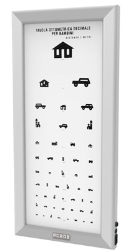CE marking is no guarantee that your eye chart is correctly manufactured!
Eye charts fall under medical devices class 1, and for class 1 equipment, it is solely up to the manufacturer to indicate whether the product meets quality requirements and guidelines for the correct execution of the eye chart.
CE marking is therefore not a guarantee of quality and compliance with standards when it comes to class 1 medical devices. It is not the quality stamp that many believe it to be – and it cannot stand alone. It is also important to verify that products comply with international guidelines such as ISO 8596. Guidelines that almost all countries in the Western world, including Denmark, have adopted, but few have chosen to enforce. As if it were not important that the screening represented by the eye test is carried out accurately.
Eye charts from Danish ISOeyes are precisely made in full compliance with ISO 8596 [cm_simple_footnote id=”1″] and fully comply with the new guidelines from health authorities that are about to be published. Including support for the Logarithmic scale (LogMAR), for more valid and comparable eye test results – also across countries.
 Take, for example, this Italian-made eye chart, which for a time was preferred in, among other places, Denmark, precisely because it was CE-approved. But CE approval is solely something the manufacturer has assigned to the product and is by no means an indication that the chart is correctly executed. In fact, it is among the most flawed charts on the market. This applies to the execution of Optotypes, which violate the basic rules of execution. The actual construction with figures per line, line spacing, figure size, and indication of measurement units, which are misleading, also violates ISO 8596 and health authorities’ guidelines.
Take, for example, this Italian-made eye chart, which for a time was preferred in, among other places, Denmark, precisely because it was CE-approved. But CE approval is solely something the manufacturer has assigned to the product and is by no means an indication that the chart is correctly executed. In fact, it is among the most flawed charts on the market. This applies to the execution of Optotypes, which violate the basic rules of execution. The actual construction with figures per line, line spacing, figure size, and indication of measurement units, which are misleading, also violates ISO 8596 and health authorities’ guidelines.
Such charts should not be present in either general practice or public health care.
![]()





